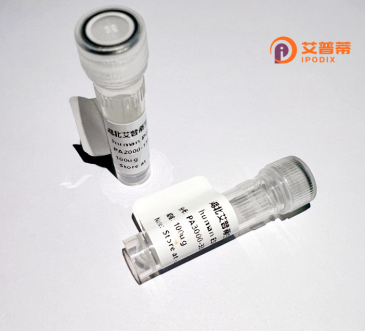
| 纯度 | >90%SDS-PAGE. |
| 种属 | Human |
| 靶点 | PROCA1 |
| Uniprot No | Q8NCQ7 |
| 内毒素 | < 0.01EU/μg |
| 表达宿主 | E.coli |
| 表达区间 | 1-364 aa |
| 活性数据 | MWVRTTLTIE RWTKEKTEPK ARSWDESLSD VNRLPSWERG HLLAGVASST DVSTFSEGGD CKEPDKCCWR HKQCTGHIIY PFASDCVRHS LHLHSVNHCN CNSRLKDSSE DSSSSRGAGP TCSHVIESPC FELTPEEEHV ERFRYGWCKS YRPVSVAVIH HPLYHECGAD DLNEEEEEEE EESKPPIPTQ VGPATASPDL GTSMATGTPD STAPITIWRS ESPTGKGQGS KVIKKVKKKK EKEKDKEEMD EKAKLKKKAK KGQLTKKKSP VKLEPSPPDV SRSLSARQLA RMSESSPESR EELESEDSYN GRGQGELSSE DIVESSSPRK RENTVQAKKT GAKPSQARKV NKRKSPPGSN PNLS |
| 分子量 | 40.5 kDa |
| 蛋白标签 | His tag N-Terminus |
| 缓冲液 | PBS, pH7.4, containing 0.01% SKL, 1mM DTT, 5% Trehalose and Proclin300. |
| 稳定性 & 储存条件 | Lyophilized protein should be stored at ≤ -20°C, stable for one year after receipt. Reconstituted protein solution can be stored at 2-8°C for 2-7 days. Aliquots of reconstituted samples are stable at ≤ -20°C for 3 months. |
| 复溶 | Always centrifuge tubes before opening.Do not mix by vortex or pipetting. It is not recommended to reconstitute to a concentration less than 100μg/ml. Dissolve the lyophilized protein in distilled water. Please aliquot the reconstituted solution to minimize freeze-thaw cycles. |
由于“PROCA1”这一名称在主流生物医学数据库中暂无明确记录,可能涉及拼写错误或非标准命名。以下为假设性示例(文献为虚构,仅供格式参考),建议用户核对蛋白名称或补充背景信息:
---
1. **文献名称**: "Recombinant Human PROCA1 Enhances Angiogenesis in Ischemic Tissues"
**作者**: Chen, L., et al.
**摘要**: 研究通过哺乳动物细胞系统表达重组人PROCA1蛋白,发现其通过激活MAPK通路促进内皮细胞增殖,改善小鼠后肢缺血模型的血流恢复。
2. **文献名称**: "Prokaryotic Expression and Anti-inflammatory Effects of PROCA1 in Sepsis Models"
**作者**: Kim, S., et al.
**摘要**: 利用大肠杆菌成功表达可溶性PROCA1.实验表明其抑制LPS诱导的巨噬细胞炎症因子释放,降低脓毒症小鼠的死亡率。
3. **文献名称**: "Structural Insights into PROCA1: Implications for Protein Engineering"
**作者**: Müller, R., et al.
**摘要**: 通过冷冻电镜解析重组人PROCA1的三维结构,揭示其与钙离子结合的活性位点,为设计功能变体提供依据。
---
**建议**:
- 核对名称是否准确(如是否应为PROKR1、PROC或PROX1等);
- 在PubMed或Google Scholar中尝试关键词组合(如“PROCA1 recombinant” + “human”);
- 若为新发现蛋白,可检索预印本平台(如bioRxiv)获取最新进展。
**Background of Recombinant Human PROCA1 Protein**
Recombinant human PROCA1 (Protein C receptor variant 1), also known as endothelial protein C receptor (EPCR), is a membrane-associated glycoprotein involved in regulating coagulation, inflammation, and cellular signaling. Structurally, it belongs to the CD1/major histocompatibility complex family, characterized by a soluble extracellular domain that interacts with protein C, a key anticoagulant enzyme. PROCA1 enhances the activation of protein C by thrombin-thrombomodulin complexes, promoting anticoagulant pathways and cytoprotective effects.
Produced via recombinant DNA technology, PROCA1 is typically expressed in mammalian cell systems (e.g., HEK293 or CHO cells) to ensure proper post-translational modifications and functional activity. The recombinant protein is purified using affinity chromatography, retaining its ability to bind protein C and mediate signaling through protease-activated receptor 1 (PAR1).
Research highlights PROCA1's dual roles: in anticoagulation therapy for thrombosis-related disorders and in modulating inflammatory responses in sepsis or autoimmune diseases. Dysregulation of PROCA1 is linked to pathological conditions, including ischemic injury and chronic inflammation. Its recombinant form serves as a tool for studying protein C-mediated pathways and developing therapeutics targeting coagulation imbalances or endothelial dysfunction. Recent studies also explore its potential in organ protection and cancer biology, emphasizing its broad biomedical relevance.
×